Updated March 16, 2024
If you’ve experienced the benefits of carry-on travel, you’ll appreciate the importance of choosing the right luggage. Making a list of the features of a perfect carry-on bag is a helpful step before making a purchasing decision.
Learn from my mistakes
My first carry-on bag was a travel backpack, loaded with features, and perfect in so many ways. Seduced by the colour and materials, I bought a matching crossbody bag.
That was my first mistake: the emphasis on colour and matchability was more important than identifying the features I needed in a crossbody bag.
My second mistake was not realizing that the absence of a sternum strap and robust hip belt was a major shortcoming in a travel backpack.
I then did what I should have done in the first place: list the features of a perfect carry-on bag to guide my search for a replacement. I didn’t get it right second time around (third time’s the charm) but here’s some of what I learned along the way.
Table of Contents
- Questions to help choose the right bag
- 1. What are you going to use it for?
- 2. What forms of transportation do you visualize in your travels?
- 3. What types of accommodation are you likely to use?
- 4. What activities might influence your choice of bag?
- 5. What kind of terrain will your bag need to negotiate?
- 6. What specialty items will need to be packed?
- 7. Will you have a second bag?
- 8. What’s the estimated packed weight?
- 9. What health or cultural factors are relevant?
- 10. What is your desired price point?
- Features of a perfect carry-on bag
- 1. Size
- 2. Internal space
- 3. Capacity
- 4. Soft-sided or hardshell
- 5. Expandability
- 6. Weight
- 7. Durability
- 8. Distinguishable
- 9. Grab handles
- 10. Attachment features
- 11 Easy-access compartments
- 12. Laptop compartment
- 13. Pockets
- 14. Compression straps
- 15. Colourful interior
- 16. Security
- 17. Rain cover
- 18. Water-resistant vs waterproof
- 19. Warranty
- 20. Replacement parts and repair centres
- 21. Luggage tag pocket
- 22. Built-in USB charger
- 23. Luggage tracker
- 24. Storing when empty
- Additional features of a good travel backpack
- Additional features to look for in a rolling bag
- Hybrid backpack and rolling bag
- Additional resources
Questions to help choose the right bag
The image of a perfect bag varies from one person to the next, and in some cases, one trip to the next. Before creating your list of the features of the perfect carry-on bag, get in touch with your travel goals, preferences, and needs as they relate to your choice of a bag. This should provide a shortcut to acquiring the right luggage without too many unwanted purchases along the way.
Here are some examples of questions to help you get started. As you work through them, picture the type of bag that might be the right fit for as many situations as possible.
1. What are you going to use it for?
Work? Travel? Hiking? Road trips? Picture the type of bag that will best suit its intended use.
2. What forms of transportation do you visualize in your travels?
International and domestic flights? Low-cost and budget airlines? Bush planes to reach isolated destinations? Cruise ships? Small boats? Trains? Buses? Camper vans? Taxis and ride shares? City transit? Motorcycle? Moped? Walking? Picture luggage restrictions and challenges, and how you’ll manage with your bag.
3. What types of accommodation are you likely to use?
Hotels? Hostels? Holiday apartments? Cabin on a barge or cruise ship? Overnight trains, buses, and ferries? Tents? Imagine a scale with ‘budget’ at one end and ‘luxury’ at the other, and picture where you (and your bag) will most likely fit.
4. What activities might influence your choice of bag?
Multi-day hikes? Bike-and-barge tours? Island hopping by watercraft? Bus tours? Tented safari camps? Imagine the possibilities and what protection might be needed for outdoor activities in various weather conditions.
5. What kind of terrain will your bag need to negotiate?
Sand, knee-deep water, cobblestones? Subway steps? Steps on a train? Escalators? Try to picture as many different scenarios as possible for clues on the best carry-on luggage to meet your needs.
6. What specialty items will need to be packed?
Camera gear? Sleeping bag? Hiking poles? Laptop? Work files? What type of internal protection will you need? What external attachment points could support some items?
7. Will you have a second bag?
Will you have a second bag such as a crossbody purse or small daypack to serve as your in-flight personal item and day bag at your destination? Will it need to nest inside your main carry-on bag so you’re only carrying one bag when you arrive at your destination?
8. What’s the estimated packed weight?
What can you realistically carry? For how long are you likely to carry your bag at any one time?
9. What health or cultural factors are relevant?
What, if any, physical, health, or cultural needs impact on your selection of a bag? Health issues? Medical aids? Culturally specific clothing?
10. What is your desired price point?
What are you willing to pay? Designer luggage packed with features can be very expensive. Cheaper pieces without a decent warranty might be cost-effective in the short term but might not stand up to the rigours of travel. A carry-on suitcase damaged during a trip can be very inconvenient.
If finances and circumstances allow, you might decide to purchase more than one bag. A travel backpack might be ideal for some trips and a rolling bag for others.
Features of a perfect carry-on bag
When buying carry-on luggage, consider the following 33 features. Once you have an idea of the type of bag that might best suit your needs, identify your ‘must-have’ and ‘nice-to-have’ features. With so many choices of bags on the market, you can afford to be picky.
1. Size
Ensure it meets the ‘45-inch rule‘ or the dimensions of your preferred airlines. There are slight variations between carriers, but most major airlines have established that the dimensions of a standard carry-on bag should not exceed 22 x 14 x 9 in / 56 x 36 x 23 cm. This amounts to 45 linear inches, or 115 centimetres.
If you plan on using low-cost and budget carriers such as Ryanair, be sure to check their dimensions before choosing a bag.
The measurements must include external pockets, wheels, or anything extending beyond the packing compartment. Many airlines are flexible with the 45-inch requirement. Some aren’t. With more competition for the limited space in overhead bins, size and weight restrictions might be more strictly enforced. As a reliable carry-on bag will likely be a significant up-front investment, it pays to get it right from the get-go.
2. Internal space
Bags with the same external dimensions rarely have identical internal volume. Design elements influence internal capacity. A box-like shape with straight sides and ninety-degree-angled corners produces the greatest available packing space.
Once curves are introduced into the design, the volume decreases. In the case of some rolling bags, handles and wheel wells can gobble up an astounding amount of internal space. Also, the dead external space between protruding wheels is not available for packing.
3. Capacity
It’s common to see the capacity of luggage measured in litres (and sometimes in cubic inches, or both). While dimensions and weight determine what’s allowable in the cabin of an aircraft, chances are that bags hovering around 50 litres or more may not pass as carry-on. If you’re committed to carry-on travel, look for luggage in the 35 to 45-litre range, and then figure out what packing light strategies you need to adopt to live within these constraints.
Need motivation to pack light? Looking for packing light tips or ideas on a carry-on bag? Check out:
4. Soft-sided or hardshell
Each has advantages and disadvantages. Hardshell bags offer better protection for the contents (unless it’s a bag with a zipper that fails). A soft-sided bag can be more forgiving when squeezing it into a luggage sizer or overhead bin.
5. Expandability
This is a handy feature but it comes at a cost. The extra zipper adds expense and weight to a bag. The expandable function can be a curse if it leads to overpacking, especially if it tips the dimensions over the ’45-inch rule.’ Needless to say, I’ve found it useful on a few occasions to nest my packed personal item when I want to carry just one bag.
6. Weight
Some airlines allow carry-on luggage up to 10 kg / 22 lb. Airlines in Asia and Australia tend to have a 7-kg limit. When plastic or metal handles and wheels are added to a bag, the weight can increase significantly. Aim for an empty weight of less than 20% of an airline’s weight limit. That’s a maximum of 2 kg / 4.4 lb for a ’10-kg carrier.’ For a ‘7-kg carrier,’ it’s 1.4 kg / 3 lb. Without sacrificing quality and durability, look for a bag weighing less than these thresholds so most of the weight comes from what’s packed, and not from the bag itself.
7. Durability
The outside of the bag needs to be water, tear, and abrasion-resistant. In a soft-sided bag, look for ballistic nylon, Cordura rip-stop nylon or Dyneema, with a high denier rating. In a hardshell bag, aluminum is the most durable but it’s heavier than polycarbonate. Rolling bags need crash protection bumpers for when they come in contact with walls, curbs, or steps.
8. Distinguishable
A bag that’s easily distinguishable from other bags, by colour or design, makes you less vulnerable to carousel theft (or honest mistakes) if you need to check your bag. On the other hand, a black bag has the advantage of obscuring dirt, debris, scuffs, and stains. It can also help you blend in. There are various ways to add distinguishing features such as luggage handle wraps or bag straps. Looking fort ideas? See:
9. Grab handles
At least two sturdy, padded grab handles should be conveniently located on the top and side of a bag. A third handle at the bottom is useful for larger and heavier bags.
Ergonomically and strategically placed grab handles permit a bag to be safely lifted and retrieved from beneath a seat, the trunk of a car, or an overhead storage compartment or luggage rack. One at the side of a bag allows it to be carried suitcase style.
10. Attachment features
It’s handy to be able to attach items to the outside of a bag from different attachment points. These might be in the form of MOLLE or daisy-chain webbing, add-a-bag clips, straps, or plastic hardware.
Being able to attach objects such as a smaller bag, damp swimsuit, flip-flops, travel towel, or a water bottle temporarily expands the packing space. It also permits convenient access to these items. It’s especially useful if it means going hands-free.
11 Easy-access compartments
A top-loading bag is more challenging to keep organized, and it’s difficult to retrieve items that aren’t at the top. These types of bags are not a good choice for travellers. A bag with front-opening or side-opening access, suitcase style, offers greater convenience. The front panel should completely open on three sides to reveal a deep main compartment.
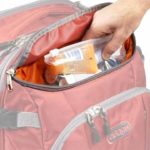 A smaller second compartment easily accessible from the outside allows you to quickly retrieve or stow items without having to enter the main compartment. This is particularly useful for a rain cover, rain jacket, or other layers of clothing. A third ‘brain’ compartment is perfect for a toiletries and cosmetics bag (known as a 3-1-1 bag in some countries).
A smaller second compartment easily accessible from the outside allows you to quickly retrieve or stow items without having to enter the main compartment. This is particularly useful for a rain cover, rain jacket, or other layers of clothing. A third ‘brain’ compartment is perfect for a toiletries and cosmetics bag (known as a 3-1-1 bag in some countries).
12. Laptop compartment
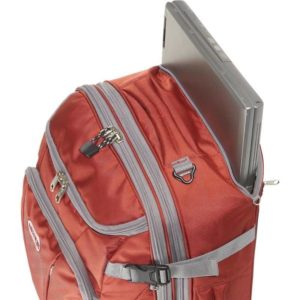 A dedicated padded, lockable compartment for a laptop or tablet keeps these items protected from damage or theft. It needs to be designed in such a way that the device can be easily removed at a screening checkpoint.
A dedicated padded, lockable compartment for a laptop or tablet keeps these items protected from damage or theft. It needs to be designed in such a way that the device can be easily removed at a screening checkpoint.
If the sleeve is positioned between the back of a backpack and the main compartment, it contributes to a more balanced load with the laptop closer to the body.
13. Pockets
External compartments and pockets should be on the same geometric plane as the main part of the bag. Pockets that protrude outwards can significantly increase the linear dimensions, without adding a commensurate amount of useful packing space.
If you’re committed to one-bag travel, an expandable water bottle pocket would be good to have.
The absence of external pockets on a hard-sided wheeled bag means the entire bag needs to be opened to retrieve anything.
Internal pockets help keep things organized and accessible. Security pockets are useful for stashing valuables. Pockets add cost and weight to a bag, so try not to be seduced by too many ‘bells and whistles.’ They can add unnecessary complexity. Look for a few simple pockets that serve a useful purpose. You can always invest in lightweight packing organizers such as cubes and compression sacs that bring function, organization, and versatility to your packing.
14. Compression straps
Internal tie-down straps in the main compartment should be durable enough to adjust to various cinch positions. These keep the contents compressed and free from shifting. They need to be wide enough so ruts aren’t left in clothing.
The role of exterior compression straps is to provide maximum compression, reduce stress on zippers, and keep the contents of a bag from moving around.
15. Colourful interior
I have two bags with bright interior fabric. It’s bright orange in the eBags TLS Mother Lode Weekender Convertible Junior. It’s bright green in the Osprey Farpoint 40. The brighter colour improves the visibility of what’s packed, and makes it easier to locate smaller items.
16. Security
While in-flight theft happens, checked luggage is more vulnerable. On a long flight, it’s impossible to monitor your bag stowed in the overhead bin at all times. Placing your bag upside down or with the zipper facing inwards will offer some protection, but a locked bag will enhance its security. Many bags have built-in locks. Some bags designed to carry specialized equipment have two locking hasps. Others have interlocking zippers for attaching a lock.
If the latter is your preference, look for self-repairing YKK chain zippers to be assured of the highest quality. Storm flaps over zippers help keep out the weather. It’s helpful to have two interlocking zippers (with short pull cords) that can be anchored to a lockable D-ring with a lock or cable tie. Or, look for two sets of interlocking zippers of the two main compartments that can be secured together with the same lock. If you stay in hostels, the lock can be used on your assigned locker.
17. Rain cover
If a soft-sided bag comes with its own integrated rain cover, there’s a good chance it will fit. If it’s attached to the bag, it’s unlikely to go missing. For through-hikes and travelling in rainy climates, it’s an important feature.
18. Water-resistant vs waterproof
A water-resistant travel bag will provide adequate protection for most city destinations and short periods of rain. Travelling to places with significant amounts of rainfall or participating in activities around water might require a waterproof bag. A waterproof rain cover on a water-resistant bag won’t protect valuable electronics if the bag becomes submerged in water. Tortuga has an article highlighting some of the key differences between waterproof and water-resistant bags.
19. Warranty
A lifetime unlimited warranty with no exceptions is the assurance a bag is well built. If it’s flawed or sustains damage, it means the manufacturer will stand behind its product. Avoid bags with ‘limited warranty’ language stating that a manufacturer is not responsible for ‘carelessness caused by an airline’ or ‘normal wear and tear.’ Briggs and Riley have a no-questions-or-exceptions lifetime guarantee. Osprey has an all-mighty guarantee covering any reason, and any product from any era. I reviewed the Osprey warranty in Is the Osprey warranty any good? It’s so good, I’m now a customer for life.
20. Replacement parts and repair centres
In the event of damage to the wheels or handle of a rolling bag, it’s usually faster and more convenient if a bag can be easily repaired without having to return it to the manufacturer. Look for brands that have self-repair kits or a full catalogue of replacement parts for the bag under consideration. If you’re planning long-term travel, having access to repair centres in different countries is beneficial.
21. Luggage tag pocket
A luggage tag pocket built into the design of a bag means never having to worry about losing a luggage tag. It should have a privacy flap to hide personal details.
22. Built-in USB charger
Some Smart bags and other luggage have built-in charging capabilities. While this feature adds weight and expense, it can be convenient in some situations. For safety reasons, ensure the battery is removable and it has both USB-A and USB-C ports to charge your existing and future devices.
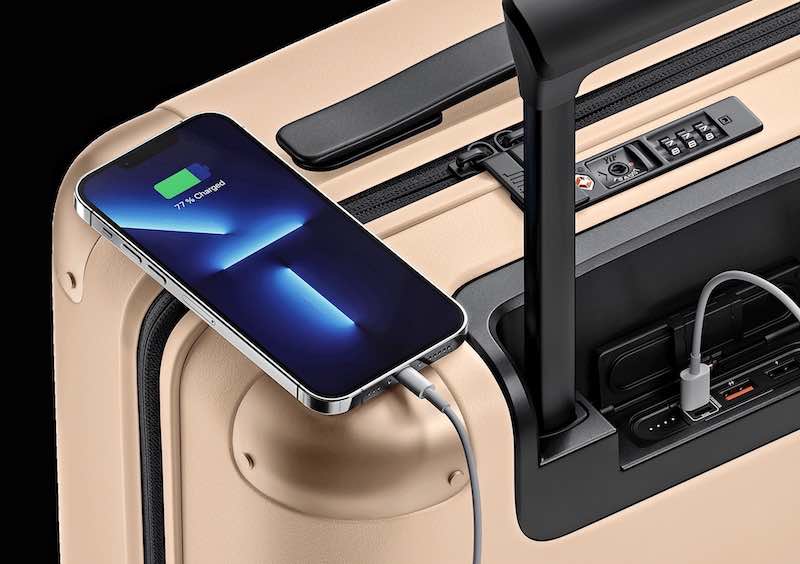 Photo credit: July
Photo credit: July
23. Luggage tracker
A bag tracker helps locate delayed, lost, or stolen luggage. It’s less common for carry-on bags to go missing, but not unheard of for a passenger to take a lookalike bag from an overhead compartment by mistake. The UK company, CabinZero has a built-in Okoban tracker in their bags. When registered with Okoban’s global lost-and-found system, the tag is integrated with the central baggage tracking system used by airlines.
Another option is to purchase a tracker that works with your phone. For iPhone users, the Apple AirTag is a solid choice. The Tile Mate tracker can be used with the Android or iOS Tile Mate app.
24. Storing when empty
A soft-sided bag without rigidly constructed walls means it can be stored flat on a shelf when empty. It consumes less storage space than hard-sided luggage that’s typically the same size and shape empty as it is full.
Additional features of a good travel backpack
25. A good fit
It’s important to find a pack that’s a good fit for your body type. You might not have plans to hike the Inca Trail, but it’s wise to be prepared with a pack that will allow you to change plans on a whim. Take advantage of the experts at your local outdoor store. In advance, figure out your torso length and hip size, although chances are the retailer will have a fitting tool.
The correct positioning of sternum, waist, and shoulder straps and load lifters is important. If purchasing online, the following videos from Deuter, Osprey, REI and Sail will help you fit and adjust your pack. Don’t forget to check your retailer’s return policy.
26. Frame
The external frame that was a common feature of older hiking packs has to a great extent been replaced with a lightweight internal frame in today’s packs. Some manufacturers add this feature to travel packs. It brings the centre of gravity of the pack closer to that of your body. This positions the weight of the bag where it can be carried with the least amount of strain. If you’ll be doing a significant amount of walking with your pack, you’ll want an internal frame. It provides structure, and in all likelihood, good ergonomic support.
27. Ventilation
Look for a back panel designed to create a small space between your back and the pack. It might be in the form of perforated or rippled foam to reflect the natural arch of your back, covered with lightweight mesh stretched tautly across the back panel. This is designed to allow air to circulate, making for a more comfortable experience.
28. Backpack straps
I love the versatility of a convertible bag, one with padded adjustable contoured backpack straps that stow away in their own compartment behind a zippered panel. Breathable moisture-wicking mesh padding where the strap (and the back of the bag) comes in contact with the body is an added feature.
Attachment points on the straps in the form of webbing or plastic hardware can be useful for attaching small items such as a whistle, flashlight, or compass. Many bags come with an additional padded strap for carrying it as a messenger bag.
29. Sternum strap
An adjustable sternum strap helps keep a backpack from moving around and subjecting the neck, shoulders, and back to stress. A built-in sternum strap whistle is an added feature, or you could add one with a sternum strap whistle kit.
30. Padded hip belt
A hip belt helps distribute as much as 90% of the weight of the bag to the hips, reducing pressure on the back and shoulders. It should be padded, adjustable and removable, or capable of being tucked away in its own pouch or compartment. Hip belts with accessory pockets place items such as a passport, phone, sunglasses, sunscreen, lip balm, or snack within easy reach. If this is a must-have feature, it might be possible to obtain compatible aftermarket attachable pockets.
Additional features to look for in a rolling bag
31. Telescoping handles
Make sure the handle is sturdy, easily retractable, and smoothly telescopes to different lengths. Test the mechanism several times. If purchasing online, scrutinize reviews.
32. Tip-free
A rolling bag should be well balanced so as not to tip over when packed. Some two-wheeled designs have front feet that double as a second or third grab handle.
33. Wheels
The size and position of the wheels should provide enough clearance from the ground so the undercarriage of the bag doesn’t scrape on uneven surfaces. The wheels on four-wheeled bags (‘spinners’) have 360-degree rotational bearings, which are almost never sealed. Look for large-diameter wheels with sealed bearings to keep out dirt, dust, and grime.
Hybrid backpack and rolling bag
If you’re undecided between a rolling bag and a backpack, take a look at the hybrid bags that offer the advantages of a rolling bag and a travel backpack. For my 46-day trip to Africa in 2023, I decided to experiment with a rolling bag. After much research, I chose the Osprey Daylite Carryon Wheeled 40L Duffel and was pleased with the results. While concerned about the absence of a hip belt, I figured it wouldn’t be an issue for the limited time the bag would be carried in backpack mode. As it turned out, the detachable backpack straps remained in a side pocket as the bag stayed in rolling mode throughout the trip.
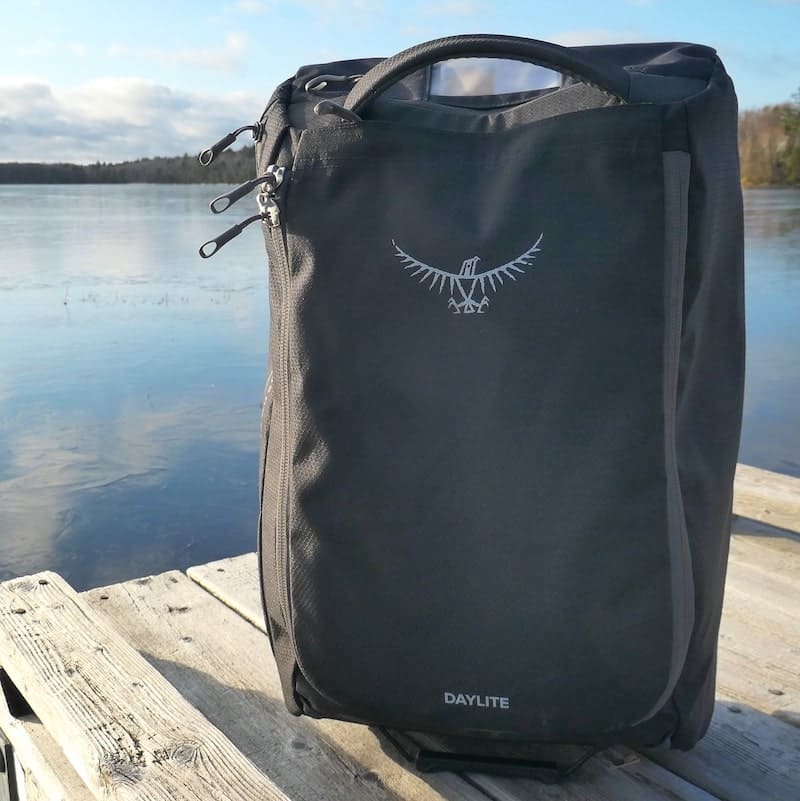
Additional resources
If you’re looking for a carry-on bag, the 5-page Worksheet for Choosing a Carry-on Bag might help. There are two versions, one for a travel backpack, and the other for a rolling bag. They list features described above, with space to record information on bags under consideration. Use them as is, or adapt them for your needs. Copies are in the Resource Library. Scroll down to the bottom of the post to sign up for access, or use the sign-up option in the sidebar.
If you’ve decided a rolling bag is for you, check out The Wirecutter’s The Best Carry-on Luggage. Even if you’re looking at bags that weren’t considered by The Wirecutter, their report provides a thorough and helpful guide to assessment criteria.
If a travel backpack suits your travel style, you may be interested in Tame dangling straps with Web Dominators. An iron-clad warranty may not be uppermost in your mind at the time of purchase, but when your bag is damaged or becomes severely weary worn, check out Is the Osprey warranty any good? It’s so good, I’m now a customer for life.
If you found this post helpful, please share it by selecting one or more social media buttons. What additional features would be added to the list? What’s your perfect (or nearly perfect) carry-on bag? Please add your thoughts in the comments. Thank you.
Care to pin it for later?
Some of the links on this page are affiliate links. If you use them to buy something, you don’t pay more, but this website earns a small commission, which helps pay the cost of running the site. Thank you for your support.


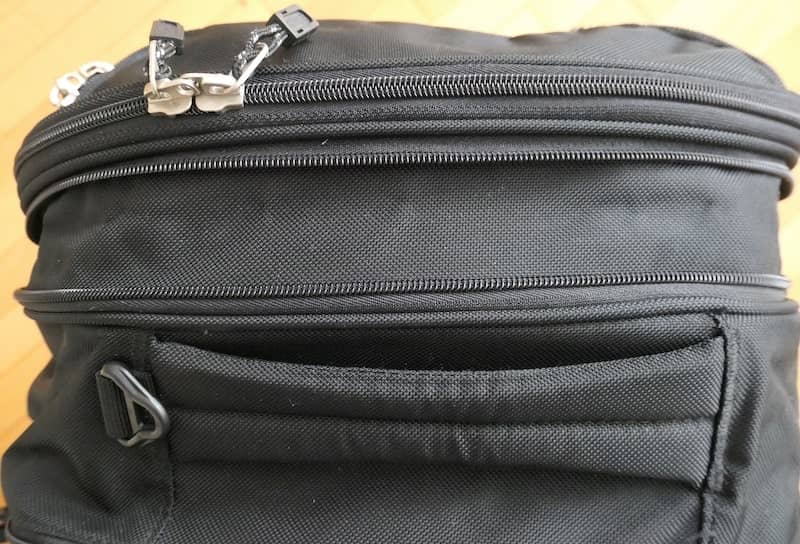
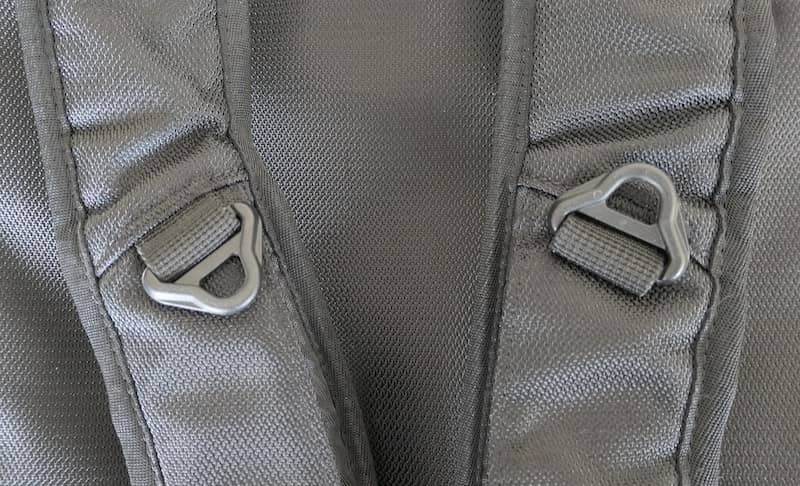
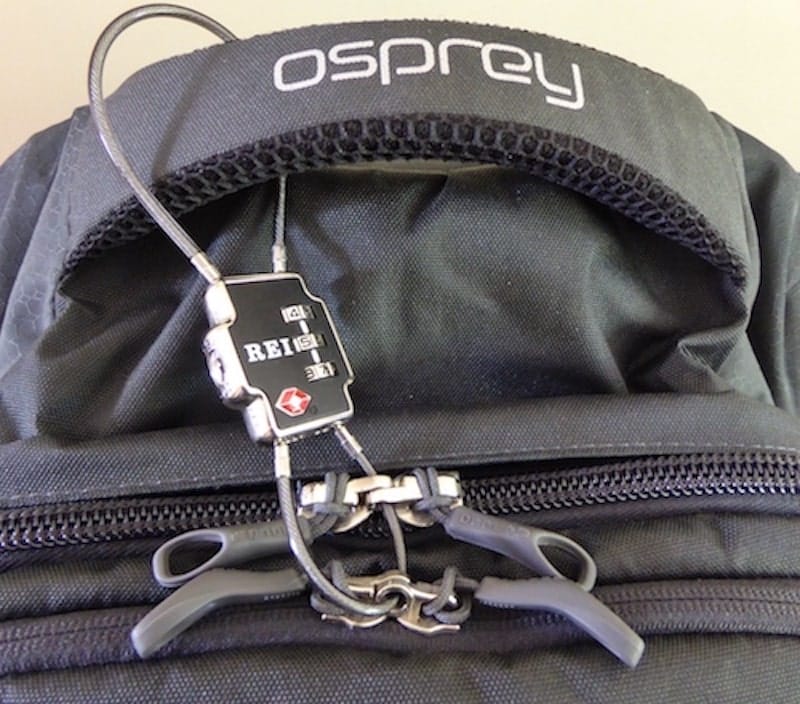
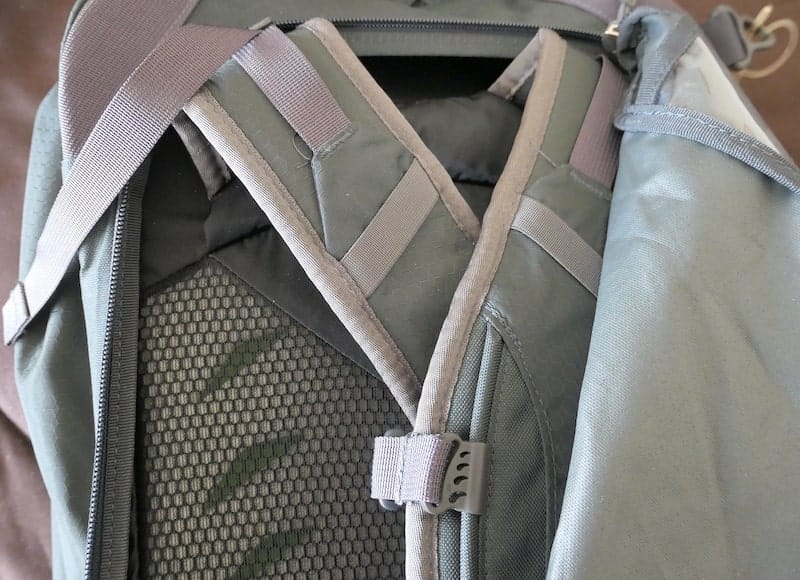
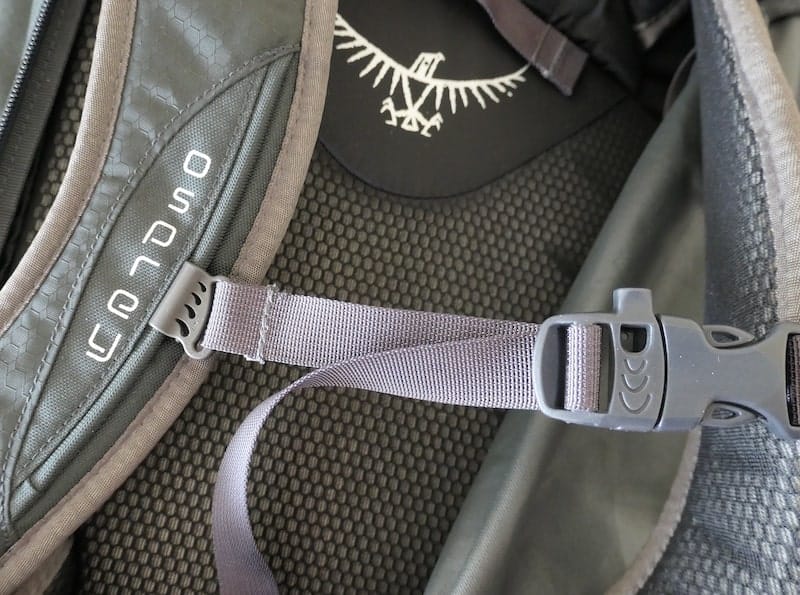
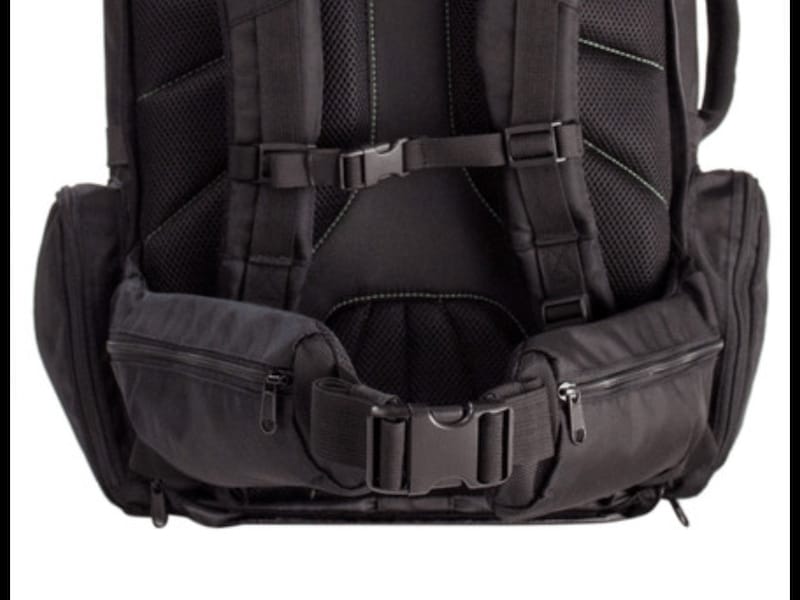
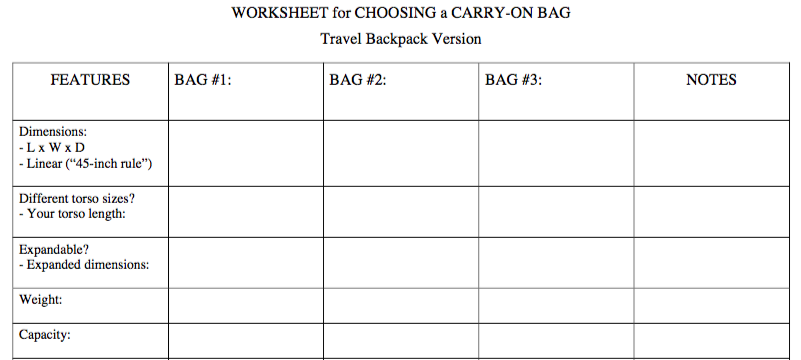
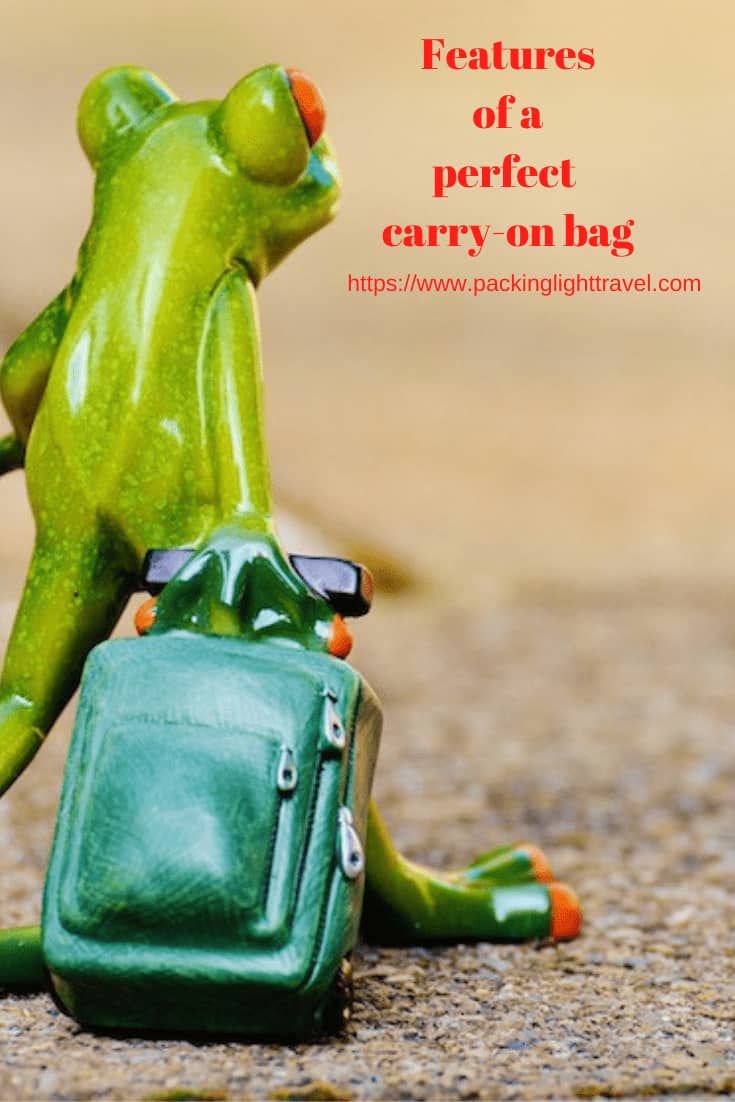




Thank you so very much for a most interesting session on packing light. I learned so much, and it was so much fun. I so very happy to have met you… thanks again
suggest trying Mountain Equipment Co-op, now a Canada wide co op that was started by mountaineers in Vancouver and Calgary decades ago. No one, but no one has the hard nosed travel needs/ experience as these folks. Travel bags are designed in house and designs based upon the rough handling needs of globe trotting, condition slogging, half-crazed travel zealots.
Thanks so much for sharing all of this advice on choosing the perfect carry-on bag! I had no idea that there would be so much to consider when it comes to choosing your luggage carrier. When I start looking for a bag for my winter vacation, I’ll definitely be sure to look for a bag that has backpack straps on it. That’s definitely a feature I would use!
Thanks for the excellent manual
http://Www.denverlinux.com/ recently posted…http://Www.denverlinux.com/
Hi Anne. I’m going to replace my carry on and am considering the Osprey Fairview 40 L. I know you just switched to this. What do you think?
Hi Shea. I switched to the Farpoint 40. I have the S-M torso size that is actually 38 litres. I like it. With packing cubes, I find it’s easy to keep organized, and its empty weight is acceptable at 3.11 lb (1.41 kg). I love the waist straps and shoulder straps. I try to keep the packed weight to around 8 kg and it’s comfortable walking with it. From what I can see, there’s not much difference between the Fairview and the Farpoint 40. Here’s a comparison video: https://m.youtube.com/watch?v=gBuh4NXkm4A
Great post! I dream of traveling light! I’m going to Europe for th first time this last year, and it will be my first solo trip. Traveling to Italy, 4 stops, by train, 14 nights… I don’t know how realistic it is to think I can do 2 weeks with carry-on only, but I’ll seriously look into it, to avoid the hassle when moving from city to city. On my last trip last year (Japan), we packed WAY too much stuff, and it was such a pain in public transportation and airports. Lots of stuff I brought I didn’t even use (I’m one of those “just in case” people haha)
You’re on the way… recognizing what a chore it was having too much luggage on your trip to Japan, and identifying what you didn’t use (and need). You can do it! There are plenty of blogs and YouTube videos to help you with tips. Good luck, Anika.
I am looking for that purse you designed. the one with the clear front.
Great tips! Traveling light is the way to go, I love the freedom and flxibility it gives!